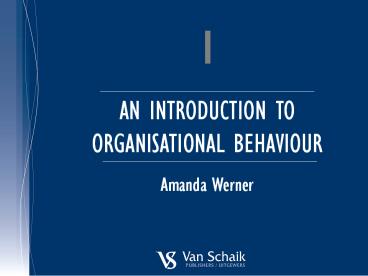AN INTRODUCTION TO ORGANISATIONAL BEHAVIOUR - PowerPoint PPT Presentation
Title:
AN INTRODUCTION TO ORGANISATIONAL BEHAVIOUR
Description:
1 AN INTRODUCTION TO ORGANISATIONAL BEHAVIOUR Amanda Werner Learning outcomes Define the term organisational behaviour and discuss the multidisciplinary nature ... – PowerPoint PPT presentation
Number of Views:3217
Avg rating:3.0/5.0
Title: AN INTRODUCTION TO ORGANISATIONAL BEHAVIOUR
1
1 AN INTRODUCTION TO ORGANISATIONAL
BEHAVIOUR Amanda Werner
2
Learning outcomes
- Define the term organisational behaviour and
discuss the multidisciplinary nature of this
field. - Give an overview of contemporary organisational
structures and designs. - Provide a profile of the 21st century manager and
employee. - Examine the challenges facing South African
organisations with regards to organisational
behaviour.
3
Introduction
- Organisations are managed in order to achieve
goals and objectives. - The focus of organisational behaviour is
organisational design, management, teams and the
interaction between people and their working
environment. - An organisation is a collection of people who
work together to achieve a variety of goals. - Behaviour in an organisation refers to the
behaviour of the individuals and groups within
the organisation, as well as the interaction
between members of the organisation and their
external environments.
4
Components of organisational behaviour
- Organisational behaviour embraces an
understanding of - peoples behaviour
- the management process
- the organisational context
- interaction with the external environment
5
Interrelated dimensions of the organisation
- The individual
- The group/team
- The organisation
- The environment
6
The interdisciplinary nature of organisational
behaviour
Overt aspects Vision, technology, equipment,
layout, dress code
Covert aspects Values, assumptions, conflict,
communication, perceptions, feelings, needs,
group dynamics
7
The interdisciplinary nature of organisational
behaviour
Multidisciplinary behavioural science
Psychology
Anthropology
Sociology
8
Organisational design and structure
- Purpose
- To coordinate the efforts of interdependent
groups towards attaining goals - To ensure information distribution and effective
decision making - To provide a formal framework for jobs, tasks,
functions and relationships
9
Span of control
1
4
16
1
64
8
256
64
512
1024
4096
4096
Span of 8
Span of 4
10
Organic structures
- Flexible networks of multi-talented people
performing a variety of tasks - Change oriented
- Foster creativity
- Generalists performing flexible tasks
- Authority decentralised
- Broad-based decision making
- Lateral communication patterns
11
Matrix structure
- Members grouped by functional and project team
- Report to two managers
- Possible problems
- Unclear lines of authority
- Significant dependence on information technology
- Increased job dissatisfaction
- Increased stress
- Individual contribution less definable
- Limited promotion opportunities
12
Other forms of organic organisations
- Virtual organisation
- Network organisation
- Boundaryless organisation
- Shamrock organisation
13
Organisational behaviour and the 21st century
manager
- Management is the process of working with and
through others to achieve organisational
objectives in an efficient and ethical manner. - 21st century managers question old assumptions
about how people in different geographical
locations work together.
14
Competencies of a 21st century manager(Gordon,
2002 150)
- Adaptability
- Knowledge and application of best practice
- Intercultural competencies
- Information technology skills
- Critical thinking skills
- Creativity
- Interpersonal effectiveness
15
Challenges for organisational behaviour
- Managing in the global environment
- Adapting to discontinuity and change
- Achieving excellence through the management of
human capital - Utilising information technology for knowledge
management - Managing a diverse workforce for competitive
advantage - Developing organisational ethics
16
Managing in the global environment
- People of different countries and cultures
perceive work and life differently
(motives/expectations) - The emergence of virtual teams
- Virtual teams pose unique challenges to
leadership. - Cohesion and trust need to be created through
shared goals. - Planning and design are key factors in the
success of a virtual team.
17
Adapting to dicontinuity and change
- Changing external environments
- Work environment often temporary
- Organisations in constant state of flux
- Managers and employees need certain
characteristics to cope in a changing environment
18
Achieving excellence through the management of
human capital
- Effectiveness
- Efficiency
- Total quality management
- Employees need to share their knowledge, insight
and experience so that the company can have a
competitive advantage - Engagement
19
Utilising IT for knowledge management
- Using people to achieve innovation and creativity
- Knowledge management need to distribute
knowledge/culture of putting knowledge into
action - Tacit knowledge
- Use of various types of technology
- Minding organisation (Rubinstein Firstenberg)
20
Managing a diverse workforce as a competitive
advantage
- Diversity also arises from cultural, political,
language, gender, religious and other
differences. - Diversity can become a companys competitive
advantage (decision making). - Companies implement diversity training
programmes. - Need to identify shared values.
21
Developing organisational ethics
- Good ethics in a company equals good reputation
of company in the market - Corporate social responsibility
- Values of the organisation are reflected in the
behaviour of its employees
22
Conclusion
- An organisation needs to adjust to a changing
environment. - Successful organisations have developed more
adaptive cultures that embrace integrated product
design teams, teamwork, quality, diversity, a
global outlook and continuous learning.

